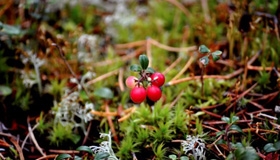
Features
Production
Research
Lingonberries: More good news for this rising star in the “super” food market
June 9, 2017 By AAFC
 Manitoba lingonberries AAFC
Manitoba lingonberries AAFCJune 9, 2017, Winnipeg, Man. – Researchers with Agriculture and Agri-Food Canada are setting the stage for what may be a new entry into the Canadian-grown “super” food market.
Lingonberries are already popular in Scandinavian cuisine where they are used in sauces for chicken and pork, as well as in muffins and breads.
Small, tart and slightly sweet, they are native to British Columbia, Manitoba, and Atlantic Canada and have the potential to become a valuable crop for Canadian growers.
The lingonberry is closely related to the blueberry and cranberry, which are also high in anti-oxidants. The benefits of lingonberries and their juice may go even further: preliminary studies in Sweden suggest there is potential to help prevent weight gain, and to help prevent high sugar and cholesterol levels.
But there’s more! New research from Dr. Chris Siow, Research Scientist with Agriculture and Agri-Food Canada and principal investigator with the Canadian Centre for Agri-Food Research in Health and Medicine (CCARM), located at St. Boniface Hospital, is showing that lingonberries may also contribute to healthy kidneys.
Here’s how: during kidney surgery, including transplants, kidneys experience low oxygen, and when oxygen is returned to the organ there can be inflammation and damage. In tests using lab rats Dr. Siow’s research team fed one millilitre (the human-equivalent of one cup) of Manitoba lingonberry juice daily for three weeks to one group and none to another prior to kidney surgery.
The rats that had consumed lingonberry juice had improved kidney function, reduced kidney stress and reduced inflammation following the operation in comparison to those that had none. These results also showed that as the concentration of lingonberry increased, the protective effect also increased.
“Overall, the research data obtained from these studies is very promising and we are encouraged that we may have a commodity that has positive impacts on human health,” said Dr. Siow. “We plan to continue with our studies to validate the early results and look for additional benefits the berry may provide.”
Meanwhile across the country, research on the lingonberry plant itself is taking place. Work with lingonberry production and germplasm enhancement is being done at AAFC’s St. John’s Research and Development Centre (NL) under the leadership of Dr. Samir Debnath. He has been working in collaboration with Dr. Siow.
“Lingonberry will be a potential health-promoting berry crop for Canada” said Dr. Debnath who developed a number of promising hybrids between European and Canadian lingonberries.
Dr. Debnath is also working in collaboration with the Newfoundland and Labrador provincial government and with Newfoundland and Labrador (NL) growers for growing lingonberry hybrids under field conditions.
Drs. Debnath and Siow not only believe that this berry will be beneficial to consumers – especially when studies like his continue to produce positive results – but that lingonberries will also be of interest to growers as they may provide new business opportunities.
Key discoveries:
- Lingonberries contain more anthocyanins, the pigments that give them their red colour, per gram than most commonly consumed berries (i.e., blueberries, cranberries). It is these compounds that may provide health benefits.
- Lingonberries are rich in vitamins and minerals.
- Lingonberries can be found growing wild in the northern regions of Canada. Research shows that the lingonberries grown in Northern Manitoba contain the highest levels of antioxidants.
Print this page